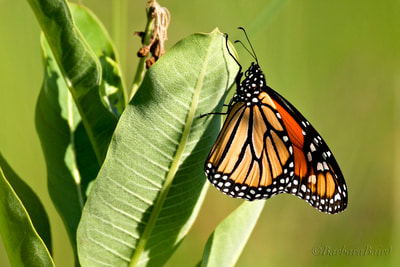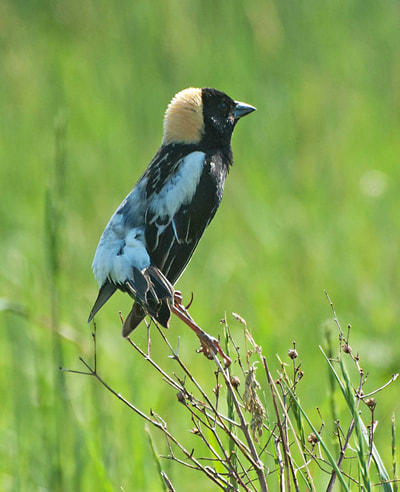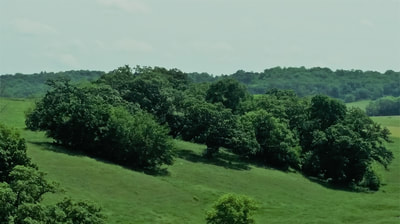My wife Dianne and I are guests of Christie Trifone-Simon, Director of Development for the Jo Daviess Conservation Foundation (JDCF), hiking a one-mile loop of the organization’s newly acquired 410-acre property located southwest of Stockton, IL. The rich range of habitat at Valley of Eden—tall and short grass restored prairie, brome grass, hardwood and orchard forest, wetlands and intermittent streams, and Rush Creek—are home to over 70 as-yet-identified bird species, including 15 species listed in “need of conservation” and/or “state-endangered.”
The result on this mid-June morning walk is a symphony of bird song.
JDCF is a private non-profit organization in northwest Illinois’ Jo Daviess County that protects and restores environmentally significant lands based on the support of members, donors, and volunteers. JDCF currently owns over 1,100 acres of woods, prairie, marsh, and archaeologically significant lands throughout the county available to public access, and they help other owners establish conservation easements on private lands as well.
Christie, who has led us on hikes before, is her usual enthusiastic self. She points out a pair of bobolinks perched on a prairie bush swaying in the breeze. The Bobolink is a migrant bird that spends part of its year in Panama, Christie explains. A grassland bird, it has been in decline in recent years as more land is cultivated and developed.
We also spook up a Meadowlark and several Red-Winged Blackbirds as we walk. The blackbirds’ nests in the grass “look like a woven piece of art,” Christie says.
As we turn a bend along the trail, we encounter the forest edge and a whole new set of birds. An oriole is swooping among the orchard trees and a woodpecker is drumming a deadwood tree stump somewhere out of sight.
The list of rare or threatened species also includes Henslow’s Sparrow and Dickcissel on the prairie grasslands, the Great Egret in the marshes, the American Woodcock and Yellow-Billed and Black-Billed Cuckoo from the forest, and the Brown Thrasher and Savanna Sparrow in the edgewood.
Future plans for the property include bird watching and photography blinds. The bird sanctuary has drawn the interest of organizations like the Audubon Society. It could well become a destination site for birders, says Christie.
“It’s like a symphony of bird calls out here,” Dianne says, and suddenly the conversation turns to the aesthetics and psychological benefits of nature.
“The experience of nature is about sight, sound, texture, and colors,” Christie responds. She tries to get kids, especially, to see nature up close. Her sentences sometimes stop mid-stream as she points out swallowtail, monarch, wood nymph, and skipper butterflies that have fluttered across her train of thought, calling out to be noticed.
The Monarch, Christie says, has a special relationship to the milkweed, and she takes us off the trail midsentence to show us the plant. Monarchs feed off its milky sap, ingesting cardenolids, which in turn make the monarchs toxic to potential predators. The loss of grassland milkweeds has contributed to the steep decline of monarchs.
Everything in nature is woven together, and Christie leads our attention next to the underside of the milkweed leaves where ants, she explains, are “farming” aphids. The ants herd the nearly microscopic insects, protecting them from predators and feeding off the aphid excretion called honeydew. “Look at the size of those ants’ mandibles,” Christie says with delight and amazement as she unfurls the milkweed leaf and examines the ants up close.
We trade the microscopic view for a broad sweeping vista from the upland forest edge down through the valley grassland and across to the woods and farm fields that rim the horizon. From here the wide range of habitat and land use is apparent.
From beyond the trail but still within the sanctuary grounds rises the lowing of cattle. Another unusual feature of the Valley of Eden sanctuary is that cattle will continue to graze certain areas to keep the forest from encroaching on the short grass habitat that some birds require for nesting. A farmhouse and cattle shed will also continue to grace the sanctuary entrance to help visitors “appreciate the history of our farming heritage,” Christie adds.
Indeed, the Valley of Eden takes its name not from the Biblical garden but from the family name of its past owners who farmed the land. But the bird sanctuary will be donated anonymously to the JDCF by its current owner who has been actively restoring the land the past 25 years, including planting prairie and new stands of hardwood forest. Having seen habitat disappear elsewhere in the country, the owner has worked to preserve and improve the grasslands and woods that sweep across this sun-drenched valley and uplands.
“The intention of the donor,” says Christie, “was to create a sanctuary for birds of many habitats. We intend to carry on that dream forever.”
The Valley of Eden Bird Sanctuary will be open to the public sometime in 2018.
There is plenty of work to do in the meantime. A new road and gravel parking lot had just been laid down the week before our visit. Volunteers can get a sneak preview by offering to pull weeds, manage a bluebird trail, take part in birding inventories, help with wildlife interpretation, and more.
A symphony of bird calls trill across the grassland at the Valley of Eden Bird Sanctuary. Bird interweaves with butterfly, ant with aphid, cow with grassland, and grassland with forest.
And as with any good orchestra, each instrument is part of the song.


